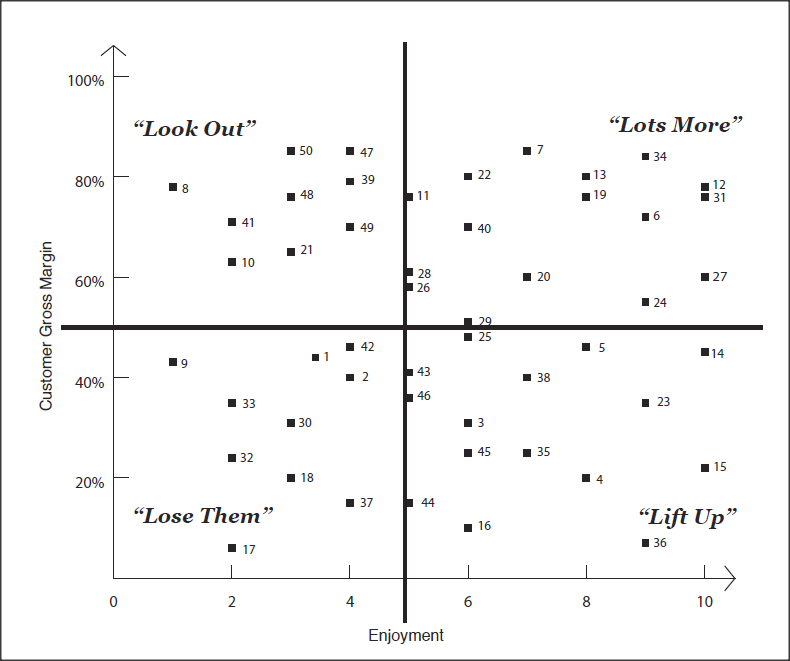Which are your MOST Profitable Customers?
Ask yourself these questions:
- How many customers do you have?
- Which customers are the most profitable for your business?
- Which customers do you enjoy working with the most and why?
The last question is probably the easiest for you to answer because you can give me an emotional response rather than a fact-based one.
The first two questions require a bit of analysis in your business.
What type of clients do you want to work with?
I find that many businesses owners have never actively thought about the profile of the customer they would like for their business. In pondering this issue, I devised a four quadrant approach to customer profitability and management. I call it my ‘L⁴ Customer Profitability Quadrant’.
Understanding Customer Profitability
Understanding the L⁴ Customer Profitability Quadrant’s power in relation to your business will require spending a bit of time working out the numbers. (Don’t worry it’s not too complicated).
For each customer we need to calculate the gross margin. Gross margin is the contribution to profit each customer makes. It’s worked out as follows:
Customer Gross Margin = | Total Customer Sales – COGS for Customer | x 100 |
So for instance, if Customer 24 buys $2000 of products/services in one year, and the cost of goods sold is $900, then the equation is:
Customer A Gross Margin = | 2000-900 | x 100 = 55 percent |
That means that for all products and services sold to Customer 24, they’re contributing a gross margin (or contribution to profit) of 55 percent.
Another way of saying this is that for every $1000 of sales made to Customer 24, $550 contributes to the business’s gross profit.
Understanding Customer Enjoyment
Don’t you think it’s important to enjoy working with your customers? I certainly do. Using the L⁴ Customer Profitability Quadrant, we can rank our customers for enjoyment, where 1 is low enjoyment and difficult to work with, and 10 is very enjoyable and easy to work with.
Once this information has been determined it is plotted to create the L⁴ Customer Profitability Quadrant as depicted in the table below.

Customers fall into four quadrants.
In the bottom left quadrant are the customers that are low in profitability and enjoyment, so I call this the ‘Lose Them’ quadrant.
In the top left quadrant we have highly profitable customers, but the enjoyment factor is low. I call this the ‘Look Out’ quadrant.
In the bottom right quadrant, are the customers that are really enjoyable to work with but they are not very profitable to the business. I call this the ‘Lift Up’ quadrant.
In the top right quadrant are the customers that are highly profitable and are highly enjoyable to work with. I call this the ‘Lots More’ quadrant.
What does each quadrant mean?
‘Lose Them’ Quadrant
How many customers do you have that are really hard going and not very profitable to your business? This type of customer sucks the life out of us, don’t you think?
Because this type of customer is difficult to work with, they are often time consuming to service too. Having to work with customers that fall in this category is a waste of time and energy. That time and energy would be better spent working with enjoyable and profitable customers and finding more profitable customers for the business.
‘Look Out’ Quadrant
Customers that sit in the ‘Look Out’ quadrant are a challenge and risk to a business. They are highly profitable, but they are not enjoyable to work with.
This is a high risk quadrant due to the profitability these customers contribute to your business, despite the low enjoyment factor. If these customers were to leave, it potentially results in a major impact on profitability. Yet, because the enjoyment factor is low, there is a real chance they may not be loyal to your business, so there is a flight risk. Ideally, your business needs to resolve any issues that are causing you not to enjoy working with them and ideally get them moved across the spectrum to the ‘Lots More’ quadrant or out of your business.
‘Lift Up’ Quadrant
Customers in this ‘Lift Up’ quadrant pose a quandary for your business. They are good customers to deal with and service, and are probably highly loyal to your business, yet they are not very profitable. Often, because these customers are good to deal with, you (and your staff) will ‘over service’ them, because they are enjoyable.
This is actually an easy dilemma to resolve. These ‘Lift Up’ customers are already wedded to your business, so given the opportunity the chances are very high that they will want to buy more from you.
Often customers are not aware of the full range of products offered, or the business has not considered the full requirements of the customer in making offers. Depending on your business, the easiest way to address this situation is to find out more about what your customers do and what they might need from your business, and make offers.
‘Lots More’ Quadrant
These customers are your goldmines, and should be treated like kings and queens. They are highly profitable, and they are enjoyable to work with.
The key here is to analyse what makes them enjoyable to work with: is it the company; the industry; the type of products and services they buy?
Once you have analysed this, you can start working on targeting more of the same types of customers to your business.
Business should be joyful
Business isn’t easy but it should be joyful, and on balance we should really enjoy serving our customers. It’s important we honour ourselves, our teams and our business by working with the very best suited customers (meaning the most profitable and enjoyable) within our business. Our success and enjoyment relies upon it.
I’d love to read your comments about your favourite and most profitable customers, so please do leave a comment for me.
Love Adèle







